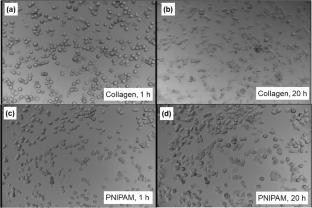Comparison of cultured cell attachment on a temperature-responsive polymer, poly-l-lysine, and collagen using modeling curves and a thermal-controlled quartz crystal microbalance
Abstract
The characteristics of cultured cell attachment onto poly-l-lysine (PLL), collagen, and the thermoresponsive polymer poly(N-isopropylacrylamide) (PNIPAM) were studied using a quartz crystal microbalance (QCM). A QCM with microscope cameras enclosed in a Peltier chamber was developed to enable QCM measurements and microphotographic imaging to be conducted in a temperature-controlled CO2 incubator. Human hepatoma cell line HepG2 cells were cultured on the quartz crystals coated with PLL, collagen, and PNIPAM. Response curves of the resonant frequency of the quartz crystals during the cell attachment process were analyzed on the basis of the parameters of modeling curves fit to the experimentally obtained curves. Analysis of the fitting curves showed that the time constants of the first-lag response were 11?h for PLL, 16?h for collagen, and 38?h for PNIPAM and that the frequency change for the PNIPAM films was six times smaller than those for the PLL and collagen films. These findings were supported by photographic images showing wider cell spread on PLL and collagen than on PNIPAM. The response of cells on PNIPAM was measured during a thermal cycle from 37 to 20?°C to 37?°C. In the resonance frequency–resonance resistance (F–R) diagram, the slopes of ΔR/ΔF corresponding to the cell attachment process and those corresponding to the thermal cycling process differed; the positions in the F–R diagram also shifted to higher resonant frequencies after the thermal cycle. These results suggested that the mass effect decreased as a result of the weakening of the cell attachment strength by the thermal cycle because the molecular brushes of PNIPAM were disarranged.


 求助内容:
求助内容: 应助结果提醒方式:
应助结果提醒方式:


